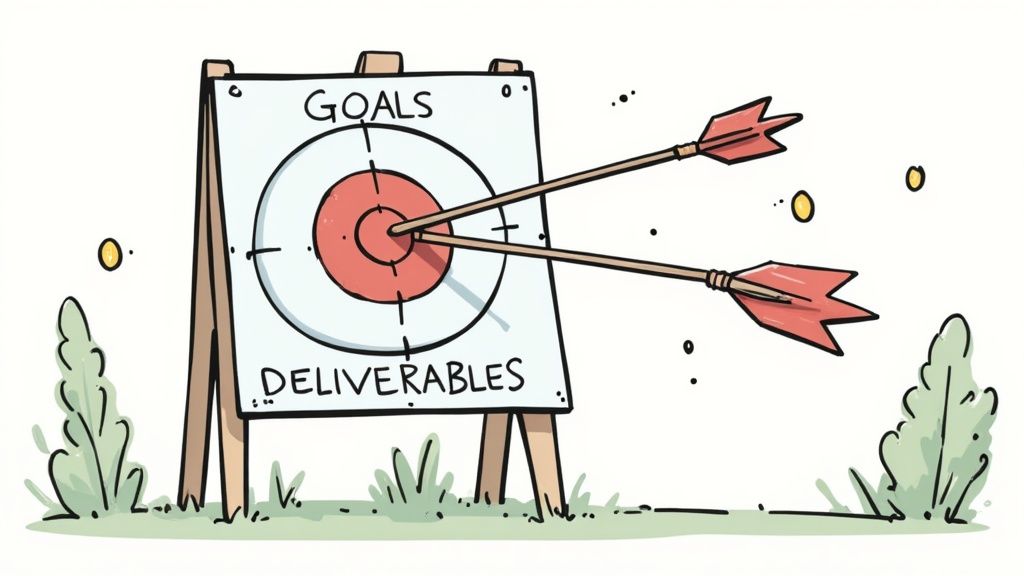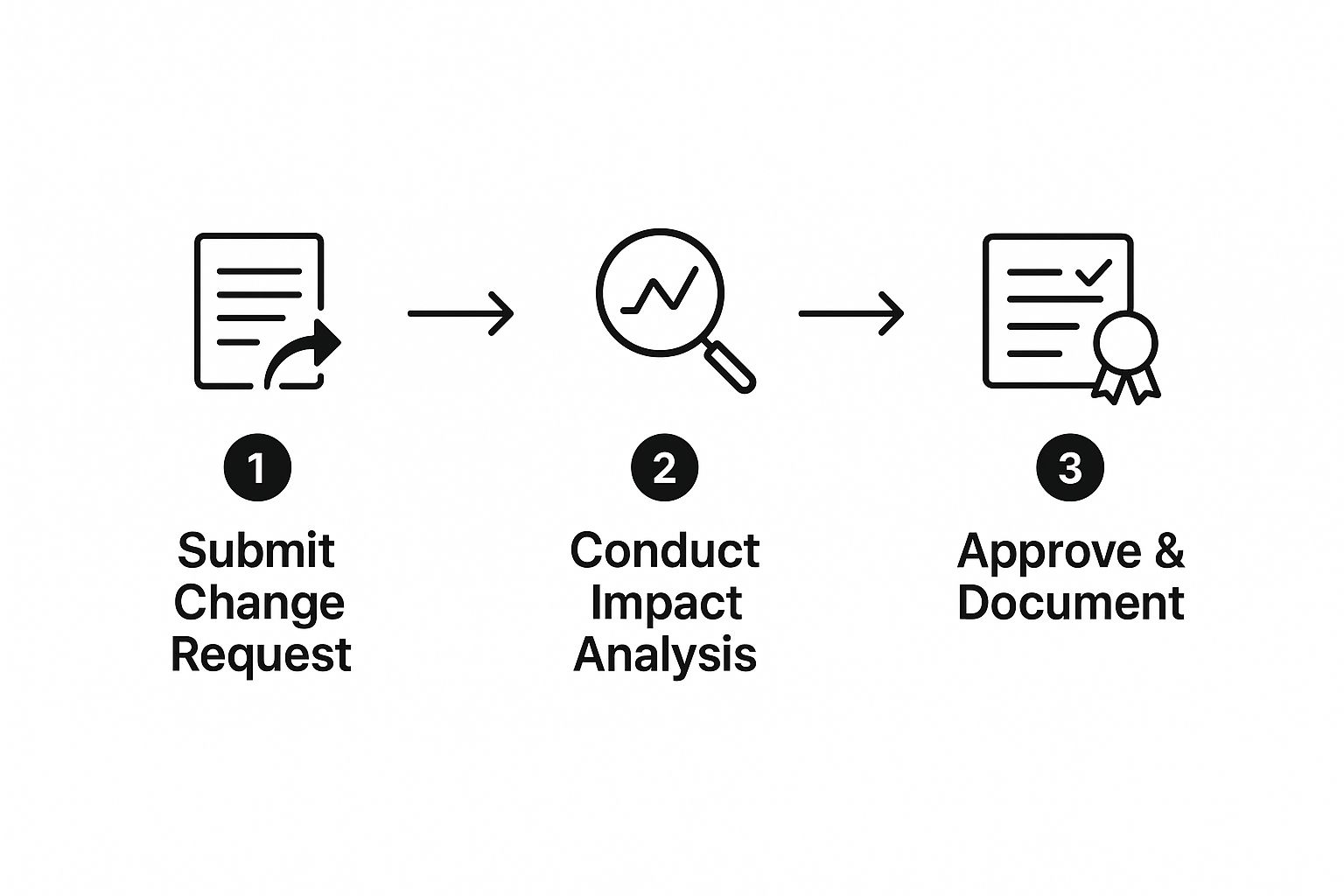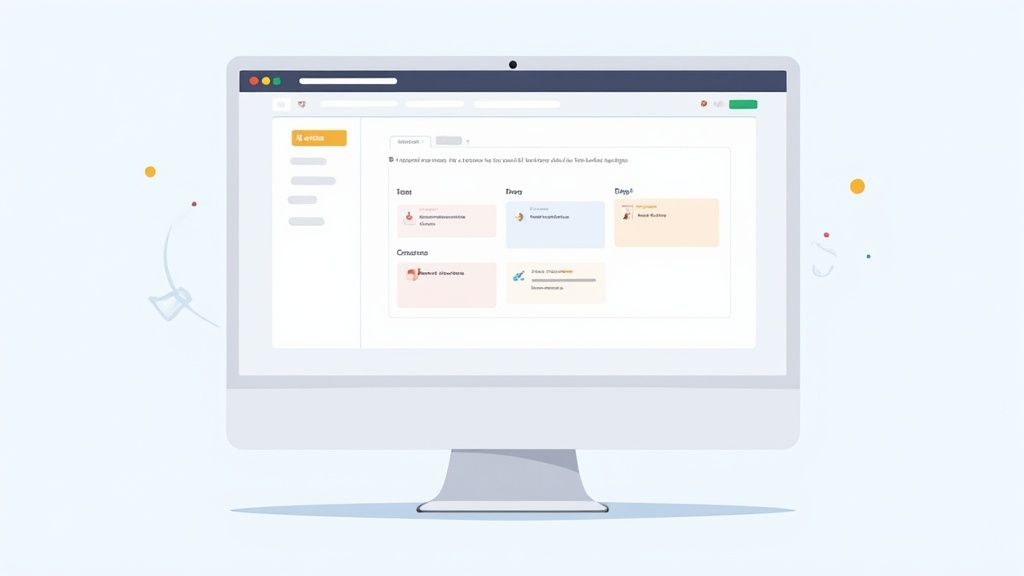How to Avoid Scope Creep: Key Strategies for Success
- shems sheikh
- May 16, 2025
- 13 min read
Recognizing Scope Creep Before It Derails Your Project

Scope creep. It's a project manager's nightmare. Often disguised as minor tweaks or "quick additions," these seemingly harmless requests can quickly spiral out of control, derailing timelines and budgets, and even impacting team morale. Recognizing the early warning signs is the key to keeping your projects on track. Understanding the potential triggers is essential, so be sure to read up on how to prevent scope creep.
Identifying the Subtle Signs of Scope Creep
One of the first red flags is the "add-on effect." This is where small, incremental requests start piling up. Imagine a client initially asks for a simple website refresh. Then, they request a blog, then e-commerce functionality, and suddenly, the project’s complexity has doubled. This leads to "feature creep," where the project expands beyond its original scope. Even seemingly minor shifting requirements can signal trouble. A mid-project design change, for instance, can mean significant rework and delays.
Client requests aren't the only culprit. Internal pressures also contribute to scope creep. "Gold plating," where team members add unrequested features they believe will improve the project, can lead to unnecessary complexity. Poor communication also plays a significant role. Unclear expectations from the start can breed misunderstandings and misinterpretations, further contributing to scope creep. The prevalence of scope creep is alarming. A 2018 study by the Project Management Institute (PMI) found that 52% of projects experience scope creep, with 43% of those suffering significant impacts on schedule, budget, and quality. For more details on these statistics, check out this resource: Learn more about scope creep statistics. This data emphasizes the critical need for proactive scope management.
The Impact of Unchecked Scope Creep
Unchecked scope creep's consequences reach far beyond missed deadlines. It can strain client relationships, damage team morale, and severely impact your bottom line. Missed deadlines breed frustration and distrust, potentially damaging valuable client relationships. Constantly shifting requirements can overwhelm team members, leading to burnout. And, of course, scope creep almost always results in budget overruns, impacting profitability and project viability. Recognizing the warning signs and implementing preventative measures is crucial for effective scope management and project success.
Drawing Clear Project Boundaries That Actually Stick

Vague project boundaries are a recipe for scope creep. Establishing clear parameters from the start is essential for project success. These parameters act as a guide throughout the project, providing a consistent reference point for everyone involved. Let's explore some practical strategies for establishing and maintaining these vital boundaries.
Crafting a Powerful Scope Statement
The scope statement is the foundation of any project. It's the ultimate source of truth for what's included and, just as importantly, what's excluded. This document should clearly define the project's objectives, deliverables, and major milestones.
For example, when developing a website, the scope statement might detail the number of pages, the functionalities required, and the planned launch date. This level of detail minimizes potential misunderstandings down the line.
Visualizing Scope with a Work Breakdown Structure
A Work Breakdown Structure (WBS) provides a visual roadmap of the entire project, broken down into manageable tasks. This detailed view helps identify what falls within the project's scope and what doesn't. This clarity is essential for preventing the gradual expansion of scope due to accumulating small requests.
Involving stakeholders in the creation of the WBS is crucial. This fosters a shared understanding from the beginning and promotes buy-in, ensuring everyone is on the same page.
Documenting Exclusions: Defining What's Not Included
Defining what's not included is just as important as defining what is included. This prevents assumptions and effectively manages stakeholder expectations.
For instance, if post-launch website maintenance isn't part of the original project, document this exclusion explicitly. Proactively addressing these potential grey areas minimizes the risk of scope creep arising from unspoken assumptions.
Scope creep continues to be a challenge across industries. As of 2025, 47% of projects face difficulties due to expanding requirements, emphasizing the need for robust scope management. Explore this topic further for industry-specific examples and templates to guide your documentation process. By documenting exclusions, you proactively combat scope creep.
Building a Change Control System That Actually Works
Change is an unavoidable part of any project. However, scope creep doesn't have to be. The secret weapon? A robust change control system. This system allows you to handle necessary adjustments while keeping the project scope from spiraling out of control. It's more than just saying "no"; it's about having a structured process for evaluating and implementing changes.
Establishing a Clear Change Request Process
Building an effective change control system starts with a clear and easy-to-use process for submitting change requests. This begins with a well-designed change request form. The form should capture all the important details: the proposed change, its justification, the potential impact on the project timeline and resources, and any related costs.

This infographic highlights the key steps in a streamlined change control process: submitting the request, analyzing the impact, and then approving and documenting the decision. This straightforward framework helps teams systematically evaluate each potential change before it affects the project scope. The progression from request to analysis to a documented decision creates a clear, traceable history for all modifications.
Setting Meaningful Approval Thresholds
After a change request is submitted, clear approval thresholds are essential for protecting the project's integrity. These thresholds should be based on the potential impact of the change. Minor changes with little impact could be approved by the project manager. However, major changes affecting the budget or timeline require higher-level approval.
Consider establishing different approval pathways for various types of requests. For example, a minor design tweak needs different approvals than a major new feature. This tailored approach allows for efficiency while safeguarding against significant scope deviations. Scope creep can have a serious financial impact, frequently leading to budget overruns and schedule delays. Studies by the Project Management Institute (PMI) show that scope creep can result in significant project overruns and misalignment with strategic goals, often due to shifting requirements and unclear objectives. Learn more about the causes of scope creep here.
Communicating and Documenting Changes
Clear communication and thorough documentation are crucial for successful change control. After a change is approved, make sure all stakeholders receive the updated information. This includes revising project plans, updating timelines, and adjusting resource allocation.
A detailed change log is equally vital. This log provides a complete record of all approved changes, their impact, and the reasons behind them. It's a valuable resource for understanding the project's evolution and helps prevent repeating past mistakes. The change log also provides important context for future decisions, allowing project teams to learn from previous changes.
To help understand the key components of an effective change control process and how they contribute to preventing scope creep, review the table below:
Components of an Effective Change Control Process
This table outlines the essential elements of a formal change control process and explains how each component helps prevent scope creep.
Process Component | Purpose | Benefits for Scope Management |
|---|---|---|
Change Request Form | Captures details of proposed change, justification, impact, and costs | Provides a standardized way to assess the impact of changes before implementation. |
Approval Thresholds | Defines who can approve changes based on their impact | Prevents unauthorized or poorly vetted changes from expanding the scope. |
Communication Plan | Ensures all stakeholders are informed of approved changes | Keeps everyone aligned and prevents misunderstandings that could lead to scope creep. |
Change Log | Documents all approved changes, impacts, and rationale | Provides a historical record to track scope changes and inform future decisions. |
This table highlights the importance of a structured approach to managing changes. Each element plays a crucial role in preventing scope creep by ensuring that all changes are evaluated, approved, and documented appropriately.
Distinguishing Between Scope Adjustments and Scope Creep
It's essential to learn the difference between valuable scope adjustments and detrimental scope creep. A valuable adjustment aligns with project goals and improves the final deliverable. Scope creep, on the other hand, consists of unmanaged additions that don't add proportional value. Using techniques like impact analysis can help you make data-driven decisions about change approvals.
By implementing a solid change control system that addresses these key areas, you can keep your projects on track, on budget, and delivering the expected value.
Managing Stakeholder Expectations Like a Pro
Unmanaged expectations can quickly lead to scope creep, derailing projects and frustrating everyone involved. This section explores practical techniques for setting and maintaining crystal-clear stakeholder expectations, ensuring project success through open communication and proactive planning. Successfully navigating stakeholder expectations is a crucial skill for any project manager.
Conducting Effective Stakeholder Analysis
Understanding your stakeholders is the first step towards managing their expectations. Stakeholder analysis helps identify key individuals and groups impacted by the project, allowing you to assess their influence and potential contributions. This process involves categorizing stakeholders based on their level of interest and power within the project.
For instance, a highly influential stakeholder deeply invested in the project requires more focused attention and communication. Conversely, stakeholders with lower interest and power may only need occasional updates. Recognizing these distinctions allows you to tailor your communication approach and allocate resources effectively. This targeted approach streamlines communication and ensures that everyone receives the right information at the right time.
This analysis also helps you anticipate potential scope risks. By understanding each stakeholder's priorities and concerns, you can proactively address issues before they escalate into major problems. This proactive approach helps minimize unexpected requests and keeps the project aligned with everyone's needs.
Establishing Clear Communication Strategies
Once you understand your stakeholders, transparent communication becomes paramount. Clearly define project boundaries from the very beginning. This includes explicitly stating what the project will deliver and, just as importantly, what it will not. This clarity helps prevent assumptions and sets realistic expectations right from the start.
When discussing scope, use precise language, avoiding technical jargon that might confuse stakeholders. Frame conversations around the project's overall goals and how adhering to the defined scope contributes to achieving those objectives. This helps stakeholders understand the rationale behind the scope and encourages their buy-in and cooperation. Clear, concise communication fosters trust and reduces the likelihood of misunderstandings.
Handling Scope Expansion Requests Diplomatically
Change requests are a natural part of any project. However, it's essential to handle these requests strategically. When a stakeholder requests a feature or change outside the agreed-upon scope, acknowledge their input positively. Then, clearly explain the impact of the change on the project's timeline, budget, and resources.
This transparency helps stakeholders understand the real-world implications of their requests. Consider offering alternative solutions. Perhaps a phased approach could incorporate the desired features later, or a smaller-scale version of the requested change could be implemented within the existing scope. This collaborative approach helps balance stakeholder needs with project constraints.
Reinforcing Scope and Educating Stakeholders
Regularly reinforce the agreed-upon scope throughout the project lifecycle. During project meetings and updates, reiterate the scope and highlight progress towards deliverables within those boundaries. This consistent reinforcement prevents scope creep from gradually taking hold and keeps the project on track.
Educate stakeholders on the ripple effect of scope changes. Clearly explain how even small additions can impact interconnected components, leading to delays or increased costs. Providing concrete examples helps stakeholders understand the potential consequences of scope expansion and empowers them to make informed decisions that consider the overall project impact. By fostering a shared understanding of scope management, you create a collaborative environment where everyone works together to achieve project success.
Creating Requirements Documentation That Prevents Problems

Vague requirements are a recipe for disaster, often leading to scope creep and project derailment. Creating effective requirements documentation is crucial for project success. This isn't just about listing needs; it's about crafting a clear, concise, and unambiguous document that everyone can rely on. This single source of truth minimizes misinterpretations and keeps everyone aligned, preventing costly deviations.
Choosing the Right Documentation Approach
Different projects demand different approaches to documentation. Traditional waterfall projects often benefit from thorough upfront documentation. This details every aspect of the project, minimizing ambiguity and providing a solid foundation.
However, agile projects thrive on a more iterative approach. Documentation focuses on the current sprint, allowing flexibility and adjustments as the project evolves. This adaptable style accommodates changing requirements and user feedback.
Effective Requirements Elicitation Techniques
Gathering requirements effectively is the bedrock of strong documentation. Engage stakeholders through various methods like interviews, workshops, and surveys. These diverse techniques help capture a broader range of perspectives and insights.
Actively listening and asking clarifying questions is key to uncovering hidden assumptions and potential ambiguities. This proactive communication ensures that all essential requirements are identified and clearly documented.
Validating Requirements and Ensuring Stakeholder Alignment
Documented requirements need validation. Stakeholders must review the documentation to ensure accuracy and completeness. Formal review meetings provide a structured setting for this scrutiny, allowing stakeholders to identify discrepancies and reach consensus.
This collaborative process is vital for aligning everyone on the scope before work begins, significantly reducing the risk of scope creep stemming from conflicting interpretations.
Maintaining Requirements Traceability
Requirements traceability is essential for managing the impact of changes. Link each requirement to specific deliverables and track modifications. This interconnectivity allows for effective impact analysis when changes occur.
Traceability helps ensure that adjustments in one area don't inadvertently affect others, preserving the project's overall integrity.
Practical Templates and Real-World Examples
To illustrate these concepts, consider how documentation might differ between Agile and Waterfall projects:
To understand these different approaches better, let's examine a comparison table:
This table compares different requirements documentation approaches based on project methodology and how they help prevent scope creep.
Project Type | Documentation Approach | Scope Creep Prevention Benefits | Potential Limitations |
|---|---|---|---|
Waterfall | Comprehensive, upfront documentation; detailed specifications | Minimizes ambiguity; provides a solid baseline | Can be inflexible; may not adapt well to changing requirements |
Agile | Iterative documentation; user stories; just enough documentation | Allows for flexibility and adaptation; incorporates user feedback | Requires strong communication and collaboration; documentation may be less detailed |
The table highlights the distinct advantages and disadvantages of each approach in preventing scope creep. The right choice depends on your project and chosen methodology. Tools like Beep, a feedback and collaboration platform, can help manage these differences. You can explore Beep's features for web project feedback and see how they facilitate requirements gathering and documentation. This demonstrates how technology can improve communication and clarity throughout the project, contributing to effective scope control. By employing these techniques, your project will benefit from a well-defined scope, minimizing miscommunication and the potential for costly rework.
Building Team Communication That Safeguards Your Scope
Your team is the first line of defense against scope creep. Establishing strong communication strategies is essential for creating a shared understanding of the project scope. This section explores practical ways to boost scope awareness within your team and helps members spot potential scope issues early. This proactive approach builds a team that becomes your strongest asset in avoiding scope creep.
Establishing Clear Roles and Responsibilities
Clearly defined roles and responsibilities are crucial for effective scope management. Every team member should know their part in maintaining project boundaries. This clarity prevents confusion and ensures everyone is accountable. For example, assigning a dedicated scope manager to oversee and track scope-related decisions can greatly improve communication and control. This person becomes the go-to expert for scope questions and ensures consistent scope management practices.
Utilizing Collaboration Tools and Techniques
Visibility into the project scope is paramount. Visual management boards, physical or digital, provide a shared view of project status and progress. These tools help teams track tasks, dependencies, and potential roadblocks, making scope deviations obvious. Platforms like Beep streamline feedback and collaboration, improving communication among team members and stakeholders. Using Beep for website feedback allows for direct annotation on live sites, making feedback clear and reducing ambiguity, a major contributor to scope creep.
Facilitating Productive Scope Discussions
Regular meetings are a great opportunity for proactive scope discussions. Team leaders should guide these conversations, encouraging open communication about potential scope concerns. Creating a safe environment for team members to voice their observations prevents small issues from becoming major scope creep problems. For example, dedicating time in regular project updates to discuss potential scope challenges can help identify and address risks early. This ongoing dialogue reinforces scope awareness and builds shared commitment to managing scope effectively.
Building a Culture of Scope Discipline
Beyond tools and processes, fostering a culture that values scope discipline is vital. This means creating an environment where team members feel comfortable raising concerns about potential scope creep. Open communication requires clear channels for ongoing scope clarification. For example, implementing a regular "scope check-in" empowers team members to share observations and identify potential risks early. Recognizing successful scope management and acknowledging those who identify potential scope issues reinforces good habits and encourages a collaborative approach to scope control.
Utilizing Real-World Scenarios and Examples
Effective training should include realistic team scenarios and communication examples. These practical exercises help team members build the skills to identify and address potential scope creep. For instance, role-playing client requests for out-of-scope work can provide valuable experience in handling these tricky conversations. Equipping your team with the communication skills and strategies they need to manage scope creates a strong defense against future scope creep challenges. This approach, along with the other techniques discussed, transforms your team into a powerful force for maintaining project boundaries and ensuring project success.
Measuring What Matters: Tracking Scope Throughout Your Project
Monitoring your project's scope isn't about micromanaging. It's about maintaining a clear understanding of progress and catching potential issues before they become major roadblocks. Just like a ship's captain uses navigation tools, project managers need effective tracking to ensure their projects reach their destination within the defined boundaries.
Establishing a Scope Baseline
Before tracking scope, you need a scope baseline. This is essentially a snapshot of the original project scope, including approved requirements, deliverables, and budget. It acts as your reference point throughout the project. A solid baseline lets you compare current progress with the initial plan and spot any deviations early.
Think of your project scope as a blueprint for a house. The baseline is the original, approved design. As the project goes on, any changes or modifications are compared to this initial blueprint.
Monitoring Key Scope Indicators
With your baseline established, you can start tracking key scope indicators. These act as early warning signs for scope creep. These indicators include:
Requirement Stability: Track how often requirements change. Frequent changes signal a potential problem, like constantly revising a house blueprint.
Change Request Volumes: Keep an eye on the number of change requests. A sudden increase might indicate scope creep.
Earned Value Management (EVM): EVM measures project performance by analyzing planned work, actual work, and value earned. It's a sophisticated way to assess whether your project is delivering value within the scope.
For example, lots of approved change requests, even small ones, can indicate scope creep. If EVM shows earned value is much lower than planned, it might signal scope-related issues.
Conducting Effective Scope Reviews
Regular scope reviews at key milestones are vital. These reviews involve comparing progress with the baseline and identifying any differences. They're not about stopping progress; they're about ensuring alignment with the agreed-upon scope. Using a standardized Pull Request Template can enhance code review quality and team communication, ensuring proper documentation and review of changes.
Think of these reviews like quality control checks during house construction. They ensure each stage aligns with the blueprint before moving on.
Implementing Scope Verification Practices
Scope verification formally accepts completed deliverables. This confirms each component meets the requirements and fits the overall project scope. It's like the final inspection of a finished house, ensuring everything matches the blueprint and specifications.
Real-World Monitoring Examples and Templates
To make scope tracking easier, use project management software with scope management features. These tools often have templates for scope statements, change requests, and change logs. They can also provide dashboards for monitoring indicators and generating reports.
For instance, a project management tool can visually track change request volumes over time, highlighting unusual spikes. You can also use pre-built change request templates, ensuring consistent documentation and easier tracking.
Ready to improve project feedback and avoid scope creep? Beep, a feedback and collaboration platform, keeps projects on track by streamlining communication and providing clear visual feedback. With direct webpage annotations, automatic screenshots, and integrations with tools like Slack, Jira, and Notion, Beep boosts workflows and team productivity. Get started with Beep quickly – no credit card required. Visit Beep now!

.png)
Comments